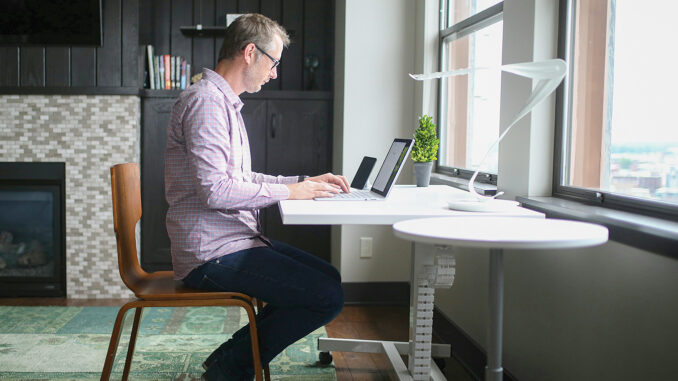
For millions who sit all day at work, chronic back pain can be debilitating and frustrating. Long hours of sitting creates more pressure on your low back than any other position. This can result in chronic muscle imbalances, core instability, and increases risks for injuries. I want to offer a few tips as to how you can prevent back pain when you sit all day.
Our bodies have the amazing ability to adapt to our surroundings and our daily conditions. This can be a positive or negative adaptation. One example of a positive adaption is when runners build a stronger heart muscle and stronger leg muscles to help them run further and faster. Adaptation can also be in a negative way when our muscles atrophy (wither away from non-use) or shorten. Examples of this are when someone is in a cast after breaking their arm (atrophy of a muscle) or when someone sits all day (shortening of supporting muscles).
The two muscles that are of most concern when you sit all day are the hamstring and the iliopsoas (aka hip flexor). They are both crucial to your lower back and are directly affected when you sit for long periods.
The hamstrings are one of the most powerful muscles in the body. They are a group of muscles on the back of your thigh that attach to the pelvis (the bone you sit on) on one end and the lower leg (tibia) on the other end. When you sit for long periods, it will cause the hamstring muscle to shorten and cause the pelvis to be restricted when you go to stand and walk.
The same problem occurs with the iliopsoas (hip flexor) muscles. The hip flexors attach to the inner thigh (femur) bone, travel deep through the pelvis, and attach to all of the bones in your low back. When you sit, it puts your iliopsoas (hip flexor) muscle in a relaxed shortened position. By the principles of adaptation, when you sit a lot it will naturally create a chronic, tight, shortened iliopsoas muscle. This typically won’t create pain or bother you until you go to stand up. When you stand up with chronically tight iliopsoas muscles they do not lengthen as easily. Due to this tightness, it can cause lower back pain.
Another problem that can occur is when people sit without the proper back support. When your chair does not have good low back support it does not support the normal curvature of the lower back (called the lumbar curve). Without the support the low back will lose its curve or, even worse, bend in the opposite direction. This can create enormous pressure on the lumbar discs, sprain the supporting ligaments around the joints, and strain the muscles of the lower back.
My top tips for preventing back pain when you sit all day is to address all these issues. The best thing to remember is the four S’s: Support, Stand, Stretch, and Stroll.
Support: When sitting be sure to have a good lumbar back chair support and use it as you sit. Make sure your lower back curve rests comfortably against the support. These can be purchased inexpensively at any pharmacy or online retailer.
Stand: Set an alarm on your computer or phone to remind you stand up every 30 minutes. You have to get the hamstring and iliopsoas (hip flexor) muscles out of that shortened position. If they stay shortened for long periods they will adapt to that position and not be easily lengthened or stretched. (Think about how you feel when you take a long car ride and then try to stand up. Do this daily and you are guaranteeing low back pain in your future.)
Stretch: Use two minutes of those standing breaks to stretch your hamstring muscles and your iliopsoas muscles. (Alternate between both legs. Do three reps of 10-second stretches with both the hamstring and iliopsoas.) You can stretch both the hamstring and the hip flexor muscles while standing or laying down.
Stroll: When standing and stretching for a couple of minutes every half hour, be sure to take 10 steps away from your desk and then come back. This will create some motion in your low back and pelvis and allow for some movement in your spine. Movement in your spine helps to increase nutrients to the lumbar discs which hydrates them and allows them to push out toxins. Disc herniations and disc damage begin when the disc weakens due to a lack of hydration. These few seconds of walking also help to reset your body and help to keep you from getting into a prolonged poor sitting posture.
Sitting at a computer desk is common these days. Unfortunately, if we are not more proactive, chronic back pain statistics will also continue to rise. Remember the four S’s (Support, Stand, Stretch, and Stroll) while you are at work and hopefully you will beat the odds and the anguish of low back pain.
-by Brandon Crouch, D.C.
About the Author: Dr. Brandon Crouch is a Chiropractor with Crouch Family Chiropractic. He is an advocate for being proactive when it comes to your health and encourages people to make healthy informed decisions. For more information or questions, you can contact him online at: www.crouchfamilychiro.com.




